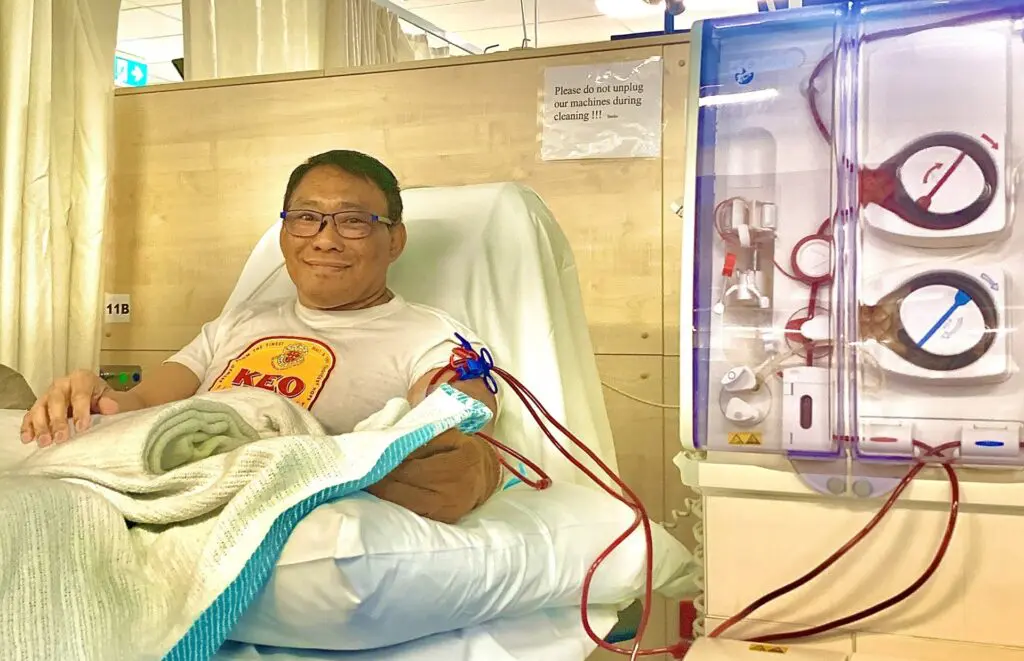
Ramon’s journey of diagnosis and treatment
When Ramon was diagnosed with type 2 diabetes in 2015, he was initially able to manage his condition with regular insulin injections and medication, as well as a good diet and exercise. However, while travelling overseas, his health deteriorated, and he was placed on life-saving dialysis.
After a career in border security, Ramon, who was 60 years old, was ready for retirement and travel. A visit to see family in the Philippines in late 2019 became extended due to the border closures during COVID-19, and it was during this time that Ramon started to feel increasingly unwell.
“I love food,” Ramon explained, “but I didn’t like the sight of it. I also had a metallic taste in my mouth, and I would vomit often. I was extremely fatigued, and even walking short distances had me gasping for breath.”
Ramon knew he should seek urgent medical help, but he didn’t want to go to the hospital as it was at the height of the pandemic, and he was concerned he would catch the virus. Over five months, his appetite decreased to eating very little until he collapsed and was taken to a medical centre in Manila.
How Ramon’s kidney failure led to life-saving dialysis treatment
People with diabetes are at risk of chronic kidney disease (CKD) which occurs when the nephrons inside the kidneys, that act as blood filters, are damaged. As the kidneys fail, it leads to a build-up of waste and fluids inside the body, which requires dialysis treatment or a kidney transplant to keep you alive.
Blood tests showed that Ramon had hyperkalaemia (high levels of potassium in the blood), metabolic acidosis (buildup of acid in the blood) was anaemic (low levels of red blood cells) and that his kidneys had failed. He was diagnosed with stage five CKD and required urgent dialysis to help clean his blood.
A tunnelled haemodialysis (HD) catheter (permacath) was inserted into Ramon’s neck vessels which lead to the top of the heart so he could receive life-saving dialysis three times a week.
Three months later when the borders opened and he was stable enough to travel, Ramon returned to Australia but had to schedule a dialysis appointment as soon as he arrived home. Thankfully his brother-in-law in Australia offered to contact Royal North Shore Hospital (RNSH) and coordinate his treatment on his behalf. Medical records were sent from the Philippines to RNSH in advance and Ramon had his last dialysis appointment in Manila on the Friday, before flying to Sydney over the weekend and recommencing dialysis at RNSH on the Monday.
Dr Emma O’Lone was assigned to Ramon as his nephrologist, and he’s been her patient for the past three years.
“When Ramon arrived in Sydney, he had recently been started on haemodialysis via a permacath,” said Dr O’Lone. “This is not an ideal long-term solution as it is prone to infection, so we prepared and trained Ramon to perform peritoneal dialysis (PD) at home, so he didn’t have to visit RNSH three times a week.”
Ramon was able to self-manage this at home for over two years with each session lasting nine hours. However, over time the efficacy of this treatment reduced, and he needed to switch back to haemodialysis, this time through a fistula in his arm.
Currently, Ramon receives haemodialysis at RNSH three times a week for five hours and his aim in the coming months is to finish HD training so he can do it at home and not travel to the hospital as frequently.
Ramon says he is delighted that the hospital is taking care of him, monitoring him, training him and making sure he stays well. He has nothing but praise for the staff and is grateful for the exceptional care he has received. He says the nurses are really patient with the cannulation, and always make sure he is comfortable while on dialysis, giving him warm blankets and food when needed.
Eliminating the burden of dialysis with a kidney transplant
“Emma is a lovely doctor, and she’s keeping track of my health,” said Ramon. “She asked me if I wanted to be on the kidney transplant program and of course, I said yes, so she’s putting me through all sorts of tests so I can have the opportunity of receiving a new kidney.”
An important part of his education is learning about his health and body and as he is working up for a transplant, he says that the appointments for blood tests and necessary scans are keeping him busy.
The wait list for a kidney transplant is five years but Ramon is remaining positive and prepared to wait if it means that he can continue travelling without the burden of dialysis. “I’m really hopeful there’s a kidney out there for me,” said Ramon.
The number of people receiving kidney replacement therapy (dialysis or kidney transplant) has more than doubled since 2003, from around 13,800 to 29,000.
Type 2 diabetes is a condition in which the body becomes resistant to the normal effects of insulin and gradually loses the capacity to produce enough insulin to control blood sugar levels.
While people may have a strong genetic disposition towards type 2 diabetes, the risk is greatly increased if people display several modifiable lifestyle factors including high blood pressure, being overweight, not being active enough and eating a poor diet.
If you would like to say thank you to healthcare staff for the care they provided to you or a loved one, please make a donation here.
